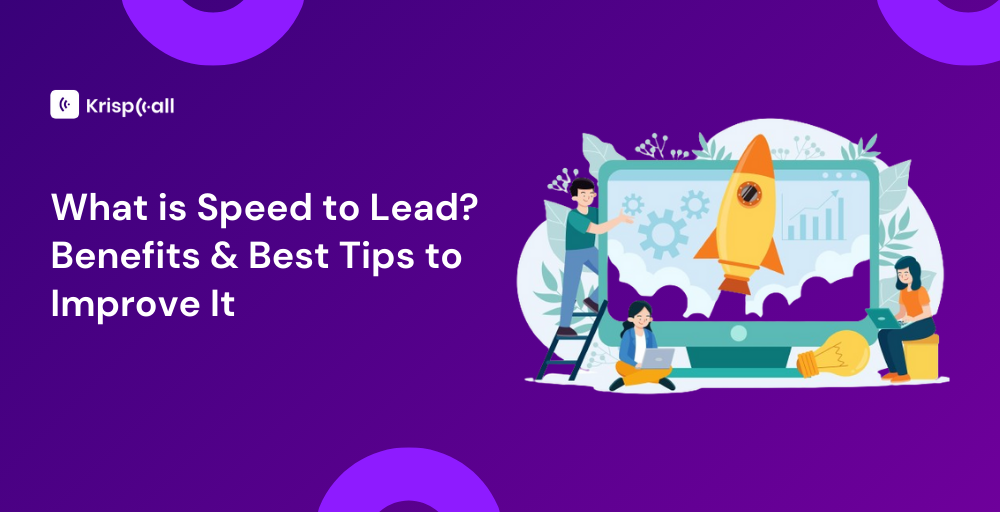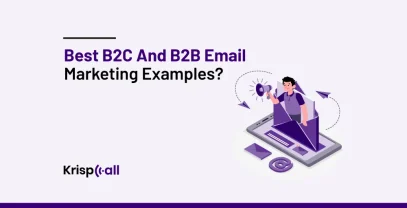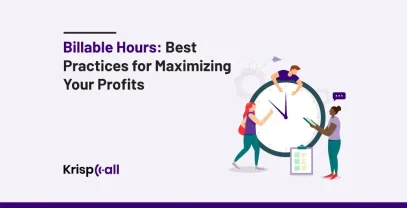Ever thought about why some businesses are great at turning leads into customers while others struggle? 🤔
It’s all about how quickly they respond – that’s what we call Speed to Lead. It’s super important for making sales work smoothly.
In this blog post, we’ll explore the idea of Speed to Lead, its importance, and ways to speed up your response to leads to increase your sales success.
🗝️Key Highlights
- Speed to lead is the time a company takes to follow up with a potential customer after showing interest, which is critical for lead conversion.
- Speed to lead significantly affects lead conversion rates, with a response within 5 minutes increasing conversions by 21 times compared to a 30-minute response time.
- Lead speed is calculated by subtracting lead creation time from the first contact time.
- Improving speed to lead involves optimizing landing pages, automating lead distribution, implementing lead scoring, and prioritizing follow-ups.
- Chatbots, AI tools, email, and SMS automation, monitoring response times, and using SLAs are key strategies to enhance speed to lead and drive conversions.
Let’s get started.🚀
What is speed to lead?
Speed to lead is the duration it takes for a company to follow up with a potential customer after they have shown interest, such as filling out a form or making an inquiry.
It’s a critical metric in sales and marketing because research shows that the faster a business responds to a lead, the more likely it is to convert that lead into a customer. Therefore, it’s crucial to prioritize speed and efficiency in lead follow-ups to maximize sales opportunities.

Speed to lead is often measured in minutes or hours from the time a lead is generated (such as through a form submission, a phone call, or an email) to the time the business contacts the lead.
For example, imagine a potential customer filling out a form on your website expressing interest in your product. They expect a quick response. If your sales team takes too long, the prospect might lose interest. But if you reach out promptly, you’re more likely to turn them into customers. That’s why optimizing your Speed to Lead is crucial.
What is the importance of speed to lead?
It’s surprising that fewer than 1% of B2B companies initiate contact with new leads within the first 5 minutes. Only 31% of companies make an effort to call their leads at all.
These statistics on speed to lead emphasize its critical role in lead conversion, meeting customer expectations, gaining a competitive edge, and improving the overall customer experience.
Let’s examine in detail why faster response to leads is essential.
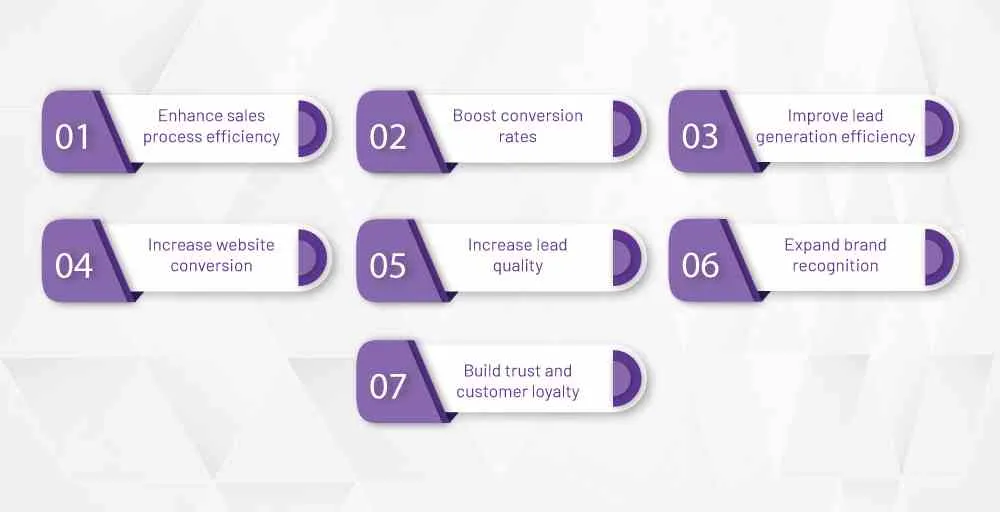
1. Enhance sales process efficiency
Improving sales process efficiency depends heavily on speed to lead. This involves closely monitoring and optimizing response times to leads. It ensures valuable opportunities are not missed.
Aligning sales and marketing teams enables effective collaboration and lead prioritization based on potential. You can implement automated tools to streamline lead handling. This helps to reduce manual effort and response delays and drive revenue growth and business success.
2. Boost conversion rates
Speed to lead is crucial in boosting conversion rates. When a company contacts a lead within minutes of their initial inquiry, the chances of converting that lead into a paying customer rise dramatically. This is because prospects are most enthusiastic and engaged immediately after expressing interest.
Responding within the first minute can skyrocket lead conversions by 391%. Even responding within five minutes is 21 times more effective than waiting 30 minutes. By acting quickly, businesses can tap into the lead’s peak interest and motivation. This prompt response showcases the company’s attentiveness and professionalism, builds trust, and greatly boosts the chances of making a sale.
3. Improve lead generation efficiency
Speed to lead is essential for boosting lead generation efficiency. Quick responses to new leads dramatically increase conversion chances and reduce lead decay. It enhances the customer experience and drives higher conversion rates.
You can optimize your lead management with different tools to prioritize and qualify leads based on their behavior. You can also use templates and call routing to automate lead delivery and speed up response times.
Chatbots and pop-ups on landing pages can instantly engage visitors, while demo request and call booking buttons trigger sales SMS, sending prospect details to the right salespeople. You can also integrate real-time notifications and analytics to continuously refine your speed and lead strategy.
4. Increase website conversion
Speed to lead plays a vital role in enhancing website conversion rates. Rapid response to website leads is key to engaging them and boosting the chances of conversion.
Besides a user-friendly website with compelling CTAs, integrating best practices of live chat, chatbots, and quick follow-up systems like automated SMS confirmations can significantly improve attendance and conversions.
5. Increases lead quality
Sales leads are most valuable when their interest is fresh. If not engaged quickly, their enthusiasm fades, and their quality diminishes.
Companies can capture prospects’ peak enthusiasm by contacting them right after they show interest. This immediate engagement enhances the lead’s quality and increases their potential value in the sales pipeline, making the sales process more efficient and successful.
6. Expand brand recognition
Speed to lead is crucial in boosting brand recognition. Responding promptly to customer inquiries creates a positive impression and shows their needs are valued. This leads to a better brand image and increases word-of-mouth referrals.
Implementing a speed-to-lead strategy enhances sales and strengthens brand reputation and recognition.
7. Build trust and customer loyalty
Speed to lead is crucial for fostering customer loyalty. Quick responses attract new leads and retain existing customers by showing value for their time and dedication to excellent service.

This swift engagement creates a positive customer service experience, conveying efficiency, eagerness to assist, and a customer-centric approach. Such attentiveness boosts satisfaction, encourages repeat business, and generates positive word-of-mouth and referrals, solidifying customer loyalty.
How is lead speed calculated?
Calculating the lead speed, or Speed to Lead, is crucial for assessing how promptly your team engages with potential customers once they express interest in your offerings. It’s essentially the duration between a lead’s inception and the initial contact made by your team.
To compute this metric effectively, you’ll need to pinpoint two critical timestamps:
Lead Creation Time: This marks when a new lead enters your system, typically triggered by filling out a web form or sending an inquiry via email.
First Contact Time: This denotes when one of your team members first connects with the new lead through an email or phone.
The formula for calculating Speed to Lead is straightforward:
Speed to Lead = First Contact Time − Lead Creation Time
Here’s an illustration using hypothetical scenarios:
- Lead Creation Time: 7:25 AM (Lead form submission)
- First Contact Time: 7:43 AM (Sales rep initiates contact)
Speed to Lead = 7:43 AM – 7:25 AM = 18 minutes
How do you improve your speed to lead? 11 Tips
Speed to lead refers to the time it takes for a company to follow up with a new lead after their initial inquiry. Improving speed to lead is crucial for maximizing conversion rates and enhancing customer satisfaction. The faster you respond to a lead, the higher the chances of converting them into a customer.
Here are some key strategies to improve your speed to lead:
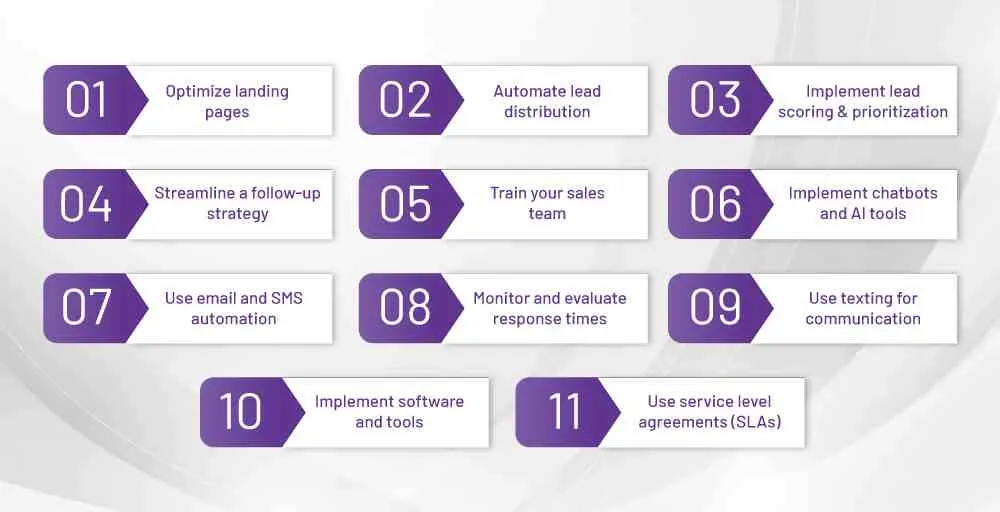
1. Optimized landing pages
To optimize landing pages for lead conversion, create a clear and compelling value proposition. You can limit navigation and include multiple prominent calls to action (CTAs) that guide visitors to convert.
To minimize friction, keep forms short and ask for only essential information. You can engage visitors with relevant video content and social proof like testimonials.
Another tip is to create a sense of urgency or scarcity to motivate conversions, such as limited-time offers or countdown timers. You can also personalize landing pages based on user segments or traffic sources to improve relevance and resonance.
By optimizing landing pages for lead conversion, you can turn more website visitors into valuable prospects and customers.
2. Automate lead distribution
Automating lead distribution involves utilizing CRM (Customer Relationship Management) or marketing automation tools to quickly and efficiently assign new leads to the most suitable sales representative. It is crucial for optimizing response times and guaranteeing no potential customers are missed.
Manual lead assignment can be time-consuming and prone to delays. Automating this process assigns leads instantly, reduces response time, and increases conversion likelihood.
Automated lead distribution ensures fair and even allocation among the sales team. It prevents any single representative from being overwhelmed and ensures all leads receive timely attention.
Tools like Salesforce, HubSpot, Zoho CRM, and Marketo are commonly used to automate lead distribution. These platforms offer advanced lead assignment rules and workflows and allow businesses to manage and assign leads efficiently.
3. Implement lead scoring and prioritization
Implementing lead scoring involves assigning a numerical value to each lead based on specific criteria, such as behavior, engagement, firmographic data, and demographic information.
By focusing on the highest-scoring leads first, your sales team can concentrate their efforts on the most promising prospects, increasing the chances of successful conversions.
Lead scoring also ensures that sales resources are used efficiently. It avoids spending time on leads that are less likely to convert. Tools like CRM systems can automate this process and provide real-time scoring and updates to streamline your sales workflow.
4. Streamline a follow-up strategy
Establish a consistent follow-up process to ensure prompt and efficient lead engagement. Define clear guidelines on target response times, specifying the maximum duration between lead creation and initial contact.
Standardize the communication methods, such as phone, email, or social media, and the frequency and cadence of follow-up activities.
By implementing this structured approach, you can maintain high responsiveness across your team and prevent leads from slipping through the cracks. Additionally, consider incorporating automated lead assignment and notification systems to optimize your follow-up strategy and drive increased conversions.
5. Train your sales team
Regular training for your sales team on best practices for rapid lead response is essential for improving conversion rates. By equipping them with efficient communication techniques, you ensure that they can engage leads effectively and persuasively. This training should include role-playing exercises, up-to-date information on the latest tools and technologies, and strategies for handling different types of leads.
Additionally, ongoing training keeps the team sharp and adaptable to changing market conditions and customer preferences. It fosters a culture of continuous improvement and helps identify areas where individual sales reps can enhance their performance. Investing in your team’s development ultimately leads to more confident, capable, and successful sales professionals.
6. Implement chatbots and AI tools
Utilizing chatbots and AI tools is a powerful way to improve speed to lead. These technologies can instantly engage with website visitors, qualify leads, and even schedule appointments, all without human intervention.
By integrating chatbots into your website or communication channels, you can respond immediately to inquiries and don’t make your leads wait. Additionally, AI tools can analyze lead data in real time and help your team promptly prioritize and respond to the most promising leads.
Moreover, chatbots and AI tools can handle routine queries and tasks. This helps free up your sales team to focus on more complex and high-value interactions. This automation speeds up lead response times and enhances overall efficiency, allowing your business to handle a higher volume of leads effectively.
7. Use email and SMS automation
Email and SMS automation are powerful tools for engaging leads immediately after they inquire. By promptly sending acknowledgment emails or text messages, you reassure leads that their communication has been received.
This creates a positive first impression and sets the stage for further communication. It fosters trust and a good relationship with potential customers.
Automated acknowledgment messages also include relevant information to keep leads engaged. These interactions help to streamline lead nurturing and maximize conversion chances with consistent communication.
8. Monitor and evaluate response time
To improve response times, consistently monitor and analyze your team’s lead data and response metrics using analytics tools. Identify trends, areas of congestion, or recurring delays to make informed adjustments and implement focused improvement strategies.
You can use these insights to streamline the response process, prioritize high-value leads, and capture prospects during peak interest. It helps to increase conversion rates and overall operational efficiency.
9. Use texting for communication
Using texting as a communication channel is an effective way to enhance speed to lead because it allows for immediate and direct interaction with prospects.
Texting enables real-time communication and makes it easier to reach leads promptly, answer their queries, provide information, and nurture relationships faster than traditional methods like emails or phone calls. It also allows for personalized and targeted messaging, increasing engagement and conversion rates.
The statistics are staggering:
- 97% of people ignore unknown phone calls.
- 90% of consumers want to have text conversations with businesses.
- The response rate for texting is 45%, significantly higher than email’s 8%.
- 90% of marketing text messages are read within three minutes.
- Americans check their phones 96 times daily, meaning they check them approximately once every 10 minutes.
- A staggering 58% of customers prefer texting as the best way to reach them.
It’s crucial to adapt and use the power of texting to stay ahead of the competition.
10. Implement software and tools
Improving speed to lead involves using software and tools strategically to streamline and expedite responding to leads generated through various channels.
- Lead Routing Software: Tools like Leandata and Distribution Engine ensure timely lead assignment. It directly leads to the right representatives promptly.
- Calendar Booking Software: Solutions such as Chili Piper and Calendly streamline customer engagement by allowing them to book meetings directly into your calendar. It improves accessibility and responsiveness.
- CRM Software: A robust CRM system consolidates customer information from various channels, equipping your sales team with comprehensive data for effective conversations and conversions.
11. Use service level agreements (SLAs)
Service Level Agreements (SLAs) are instrumental in enhancing lead response times. It defines appropriate response times based on lead quality and ensures responsibility and operational efficiency.
Organizations foster a culture of responsiveness and effectiveness in handling leads by setting up and operationalizing SLAs. This structured approach, including defining response times, establishing accountability, and monitoring performance, contributes to a well-coordinated system focused on timely engagement and conversion.
Wrapping up
Speed to Lead is critical in turning potential leads into loyal customers. The faster a company responds to a lead, the higher the chances of conversion. By implementing strategies such as optimizing landing pages, automating lead distribution, and utilizing AI tools, businesses can significantly enhance their response times and boost their conversion rates.🚀
Incorporating Speed to Lead best practices improves lead generation efficiency, enhances overall customer experience, builds trust, and fosters customer loyalty. These strategies will help businesses maximize their sales opportunities and achieve long-term success.💫
FAQs
What is the meaning of lead speed?
Lead speed is the time a business or sales team takes to respond to a lead or customer inquiry after it has been generated. It measures how quickly a company engages with potential customers after showing interest in products or services, such as filling out a contact form, subscribing to a newsletter, or requesting information.
What is the speed-to-lead strategy?
The speed-to-lead strategy is a business approach that prioritizes rapid response times to incoming leads. It involves setting specific time goals for responding to leads, such as within minutes or hours of lead generation. The strategy aims to capitalize on the momentum of customer interest, increase engagement, and improve conversion rates by promptly addressing customer inquiries and needs.
What should be your speed to lead?
Your speed to lead should ideally be as fast as possible within practical constraints. Studies have shown that responding to leads within minutes significantly improves conversion rates compared to delayed responses.
However, the exact speed to lead goal can vary based on industry norms, business resources, and the complexity of lead interactions.
Is speed to lead really outdated?
No, speed to lead is not outdated. It remains a critical aspect of successful sales and customer engagement strategies.
With the increasing emphasis on customer experience and instant gratification, businesses prioritizing fast response times to leads are more likely to capture customer interest, build trust, and drive conversions. Speed to lead is relevant and essential in today’s competitive business landscape.
How does the speed of calling influence lead conversion rates?
The speed of calling, which is a key component of speed to lead, can significantly impact lead conversion rates. Promptly following up on leads with a phone call or personalized communication demonstrates attentiveness and a genuine interest in addressing customer needs.
Studies show that leads contacted within minutes of inquiry are more likely to convert into customers than those contacted later. Fast calling speed can lead to higher engagement, improved lead quality, and business conversion rates.
Is speed to lead relevant across different industries?
Yes, Speed to Lead is relevant across various industries, including retail, real estate, healthcare, finance, and B2B services. Regardless of the industry, responding quickly to leads and customer inquiries drives business growth and fosters positive relationships.

